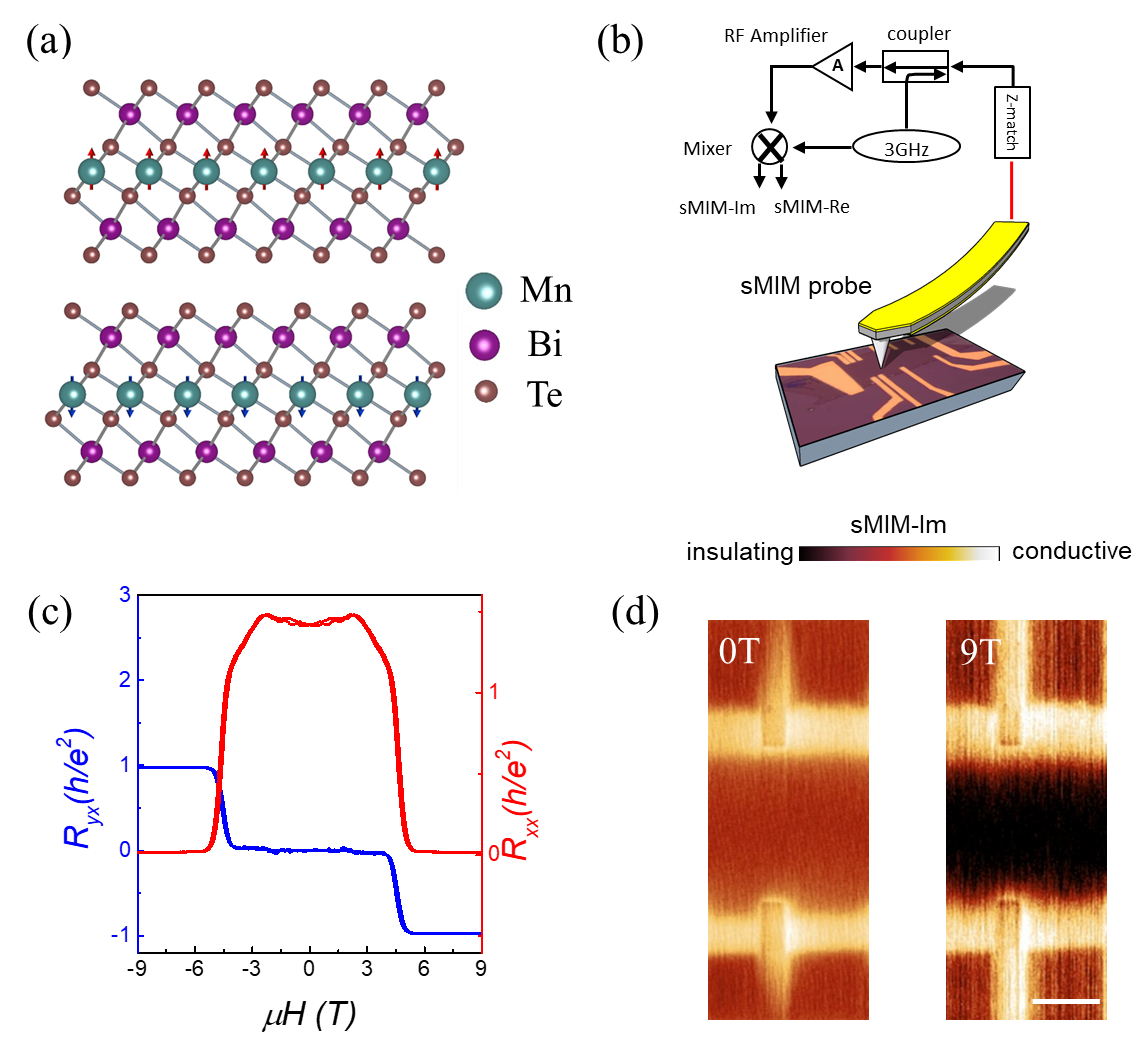A new research conducted by our group reported a topological conducting edge state in antiferromagnetic topological insulator (AFM-TI) MnBi2Te4. This was a collaboration with Prof. Yihua Wang from Fudan University, Prof. Jinsong Zhang&Yayu Wang’s group from Tsinghua University and Prof. Chui-zhen Chen from Soochow University. The results were published online in Nature Communications on December 13, 2022, entitled with “Direct visualization of edge state in even-layer MnBi2Te4 at zero magnetic field”.
The study of topological quantum state of matter has become an important branch of condensed matter physics research, in which the interplay between topology and magnetism can generate a variety of new topological phases best exemplified by quantum anomalous Hall effect (QAHE). QAHE was first realized in magnetically doped TI film Cr-(Bi,Sb)2Te3. However, its observation temperature was restricted to below 100 mK because of the magnetic doping induced disorders. MnBi2Te4 is considered to be a better candidate to realize high-temperature QAHE because the magnetic disorder will be greatly suppressed in such an intrinsic AFM-TI compound. The building block of MnBi2Te4 is Te-Bi-Te-Mn-Te-Bi-Te septuple layer (SL). Within each SL, the magnetic moments of Mn are aligned ferromagnetically along the out-of-plane direction. They couple to each other antiferromagnetically between adjacent SLs forming an A-type AFM (Fig. 1a). Using stope tape method, one can easily obtain MnBi2Te4 thin flakes with a few atomic-layer thickness due to its van der Waals bonding character. Theory predicts QAHE in odd-SL MnBi2Te4 thin flakes due to its finite net magnetization, which was soon confirmed by a transport experiment. Another topological phase termed “axion insulator” is also predicted in even-SL MnBi2Te4 thin flakes considering that its layer magnetization is perfectly cancelled out. A zero Hall plateau (ZHP) was observed in a transport experiment of 6-SL MnBi2Te4, corroborating such an axion insulator picture. An applied external magnetic field drives an AFM to FM magnetic phase transition in 6-SL MnBi2Te4. At the same time, the system undergoes a topological phase transition from an axion insulator at zero field to a Chern insulator at high fields.
Our group employs a scanning microwave impedance microscopy (sMIM) to study 6-SL MnBi2Te4. sMIM is a recently developed scanning near-field optical microscopy working at microwave frequencies (~ 3 GHz). By measuring a local microwave reflectance from the sample surface, it can characterize sample’s local conductivity or dielectric property with a spatial resolution down to 50 nm (Fig. 1b). We first use transport to measure 6SL-MnBi2Te4 and observe a quantized Hall resistance at high fields (larger than 6 T) indicating a Chern insulator phase (Fig. 1c). At low fields, a ZHP is observed suggesting an axion insulator phase. We then use sMIM to perform a local conductivity imaging. As shown in Fig. 1d, at 9 T, sMIM imaging reveals an insulating bulk (small sMIM signal) and a conducting edge (large sMIM signal) confirming that 6-SL MnBi2Te4 is in a Chern insulator phase at high fields hosting a topological conducting edge state. Surprisingly, sMIM imaging reveals another conducting edge state at 0 T. This observation is in a direct contradiction to the axion insulator picture because an axion insulator requires a complete gap opening of all 2D surface states in 3D TI. Therefore, the material is insulating from the bulk to its surface. We perform additional theoretical calculations on 6SL-MnBi2Te4 and suggest that, the system is now in a time reversal symmetry (TRS) broken quantum spin Hall state (QSH). Such TRS broken QSH phase hosts a pair of helical topological edge state with a tiny gap due to the TRS breaking. However, such gapped helical edge state will become gapless due to disorders offering an explanation to our experimental observations.
The interest on the axion insulator state is largely due to its topological magnetoelectric effect (TME). Previous experiment has reported such an axion insulator state in “FM/TI/FM” heterostructure. Even-SL MnBi2Te4 is now believed to be another axion insulator system, gaining supports from the transport observation of ZHP. However, our work points out that, ZHP is a necessary but not sufficient condition of an axion insulator. We must be caution enough in our continuous search for such a topological phase.

Figure. (a) The MnBi2Te4 crystal structure. (b) The sMIM schematic. (c) The transport experiments of 6-SL MnBi2Te4. (d) The sMIM imaging of 6-SL MnBi2Te4 at 0 T and 9 T. Scale bar is 2 mm.
Paper link: https://doi.org/10.1038/s41467-022-35482-0